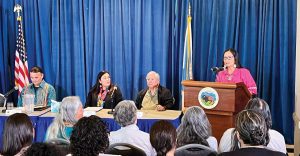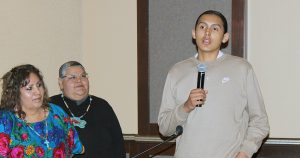By the CUJ
MISSION – A “softer” approach to restoring habitat on Meacham Creek has yielded another environmental stewardship award for the Confederated Tribes of the Umatilla Indian Reservation.
This time the Meacham Creek – Bonifer Reach Restoration Project (Bonifer), which has been underway about five years, has been selected for the Society of Ecological Restoration Northwest Chapter’s “Restoration Project of the Year Award.” The Northwest region includes Washington, Oregon, Montana, Idaho, Alaska and Northern California.
Previously Meacham Creek restoration efforts have resulted in a 2012 award from the U.S. Forest Service National office and in 2018 from the Western Division of American Fisheries Society, which includes Oregon, Washington, California, Idaho, Nevada, Arizona, New Mexico, Colorado, Montana, Alaska and British Columbia.
CTUIR Department of Natural Resources Director Eric Quaempts said the improvements to Meacham Creek have been obvious. Since 2009, DNR Fisheries staff have treated and or protected about 350 acres of floodplain and eight stream miles in lower Meacham Creek.
“To date, Fisheries and GIS staff have documented changes in stream temperatures, and spring Chinook spawning and rearing in restoration reaches, in areas that had not experienced spring Chinook spawning for many years,” Quaempts said in an e-mail. The work has also provided spawning and rearing habitat for Pacific lamprey.
According to Quaempts, ongoing monitoring of floodplain restoration have shown to buffer high summer water temperatures, improve ground water storage and hyporheic exchange, improve growing conditions for native riparian vegetation, and enhance aquatic habitat for ESA-listed Mid-Columbia River summer steelhead and bull trout, spring Chinook salmon, Pacific lamprey and other native fish in Meacham Creek.”
Water and fish are important components of the First Foods serving order traditionally used in the Longhouse.
The Bonifer project focuses on nearly four river miles along the lower stretch of Meacham Creek, which is the primary tributary to the Umatilla River in northeast Oregon.
The CTUIR’s Fisheries Umatilla Fisheries Habitat Project, headed by Project Leader Richard Christian in the Tribes’ Department of Natural Resources, collaborated with Tetra Tech, Inc., to develop a “softer” approach to restoring the Bonifer Reach Project area.
Christian said it is important to understand that each section of stream is different, which dictates different restoration strategies.
“In this particular instance the design team deemed a lighter approach as appropriate … Throughout the development of the design, our approach consistently included ways to reduce the overall impact and project footprint.”
More importantly, Christian added, this approach will require less rehabilitation and lead to a quicker recovery of some project elements, such as floodplain vegetation.
Like many of the region’s waterways, Meacham Creek has changed dramatically in the time since European Americans settled the area, according to Chris James, Tetra Tech’s project manager/hydrologist, who nominated the Tribes’ floodplain restoration for the award.
“Over one hundred years of human activity, including the construction of the Union Pacific railway in the valley bottom, flood protection diking, and the grazing of livestock has altered and degraded the Meacham Creek watershed and its floodplain,” James wrote in his nomination letter. “This has resulted in a greatly simplified channel, immature riparian vegetation, high stream temperatures, low summer flows, lack of aquatic habitat complexity, and limited quantities and recruitment of large woody debris, all contributing to decreased aquatic productivity and altered fluvial processes.”
DNR Director Quaempts reiterated James’ points.
The historical altercations made Meacham Creek stream temperatures less suitable for native fish, and changed the availability of suitable spawning materials, Quaempts said.
Toward rectifying those issues, “Floodplain restoration efforts are aimed at improving water quality and fish habitat for a variety of aquatic First Foods, including spring chinook salmon, threatened summer steelhead, Pacific Lamprey, and restoring suitable spawning and rearing habitat,” Quaempts said.
The Tribes have been actively restoring “ecological processes” in the Meacham Creek watershed since the 1980s, but since 2009 have invested in three large-scale floodplain restoration efforts. The first two projects addressed 2.5 river miles starting about six miles upstream from the mouth.
According to James, the overall objectives of the projects has been to provide opportunities for recovery of geomorphic, hydrologic, riparian, and in-stream processes based on historical and reference conditions.
“Natural recovery is expected to continue decades into the future and on-going monitor has confirmed the trajectory,” James wrote in his nomination letter.
Collectively, the three large-scale efforts removed three miles of levees and spur dikes, realigned two miles of channel, reconnected three miles of side channels, placed 5,000 pieces of large wood debris, planted 87 acres, and enhanced five acres of wetlands.
Specifically, Phase I entailed removing 3,400 feet of levee and spur dikes, realigning 5,922 feet of Meacham Creek into its historical channel, placing more than 1,400 pieces of large woody debris, and constructing three side channels over 6,000 feet long, and one wall-based channel over 2,000 feet long. The project increased the stream habitat in the project area (mainstem, side channels and tributaries) from approximately 7,540 feet to more than 13,000 feet.
The Phase II activities included removal of more than 5,000 feet of levees and spur dikes, installing some 565 pieces of wood for log jams, and reconnecting a 1,960-foot-long channel to the mainstem.
The third phase – the Bonifer Reach activities – include removing more than 7,125 linear feet of levees and spur dikes and constructing more than 5,900 feet of new channel, off-channel and side channel habitat with more than 2,500 pieces of wood and 160 different log jams, installation of bioengineering techniques, and revegetation of all disturbed areas, as well as improvements to wetlands.
These floodplain restoration projects, James wrote, have already proven to buffer high summer water temperatures, store flood water in the floodplain in the spring to augment summer low flows, enhance aquatic habitat in Meacham Creek, and increase native riparian vegetation throughout the floodplain.
“The CTUIR have made incredible advances in the restoration of the Meacham Creek watershed in these floodplain reaches and will continue to do more upper portion of the watershed in the future. They truly are worthy of recognition for these efforts to their lands,” James wrote.
In an award-recognition letter to Rick Christian, Umatilla Basin Project leader, Amy Sacry, a sub-regional representative of the Society for Ecological Restoration Northwest, said the “long-term commitment of the CTUIR to aquatic habitat and floodplain restoration significantly contributes to the advancement of ecological resource science and practice in our region.”
Sacry’s letter also commended the CTUIR for building a “wide range of working partnerships, a key factor in successful comprehensive restoration.”
Supporting agencies for the Meacham Creek Bonifer project include funding partners Bonneville Power Administration, U.S. Environmental Protection Agency, National Marine Fisheries Service (Pacific Coastal Salmon Recovery Fund) through regional support by Columbia River Inter-tribal Fish Commission, and the Oregon Watershed Enhancement Board.
Primary construction ended in early October, but Umatilla Habitat Project staff are expected to finish their annual fall planting on the project by the end of November.
That concluded a five-year effort that started in May 2015 that included more than two years to receive permitted and permissions from the CTUIR and landowners.
“We will likely do an additional contract in the next year or two to add more wood, if needed,” Christian said. “It was a very long time in development, but we got there.”
Key DNR Fisheries staff who worked on the Meacham Creek Bonifer project include Christian, Lambert, Ethan Green, Gary James, Julie Burke, Mikayla Kelly, Randy Bonifer (now retired), Larry Allen, Sean Van Pelt, Jesse Bevis, Austin Samuels and Ian Sampson.
“Our staff and their work are highly regarded in their profession, and the repeated and significant acknowledgements of their work are indicative of their dedication and work quality,” Quaempts said.
The Society for Ecological Restoration makes the annual award “to a public, private, non-profit-owned and/or sponsored/implemented restoration project, or a collaboratively owned and/or implemented restoration project making a significant contribution to restoration in the Cascadia bioregion.”
The award was announced at the Society’s annual meeting Nov. 17. The meeting was a Zoom video conference. Christian from the CTUIR gave a presentation of the Bonifer Reach work during the annual meeting.



